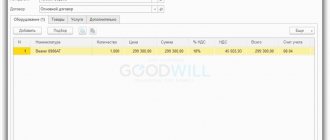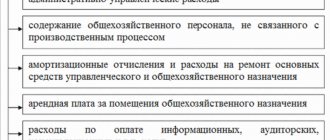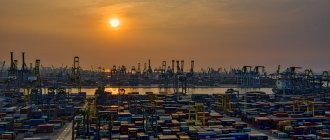Direct and indirect costs: what are they?
According to Art. 318 of the Tax Code of the Russian Federation, production and sales expenses incurred during the reporting (tax) period are divided into:
| Direct expenses | Indirect costs |
| · expenses for the acquisition of raw materials and (or) materials used in the production of goods (performance of work, provision of services) and (or) forming their basis or being a necessary component in the production of goods (performance of work, provision of services); · expenses for the purchase of components undergoing installation and (or) semi-finished products undergoing additional processing from the taxpayer; · expenses for remuneration of personnel involved in the production of goods, performance of work, provision of services, as well as expenses for compulsory pension insurance, compulsory social insurance in case of temporary disability and in connection with maternity, compulsory medical insurance, compulsory social insurance against accidents cases at work and occupational diseases accrued on the specified amounts of labor costs; · the amount of accrued depreciation on fixed assets used in the production of goods, works, and services. | Other amounts of expenses, with the exception of non-operating expenses incurred by the taxpayer during the reporting (tax) period. |
The taxpayer independently determines in the accounting policy for tax purposes a list of direct expenses associated with the production of goods (performance of work, provision of services).
It is worth paying attention to the procedure for accounting expenses:
| Direct expenses | Indirect costs |
| The amount of indirect costs for production and sales incurred in the reporting (tax) period is fully included in the expenses of the current reporting (tax) period. Non-operating expenses are included in the expenses of the current period in a similar manner. | Direct expenses refer to the expenses of the current reporting (tax) period as products, works, and services are sold in the cost of which they are taken into account. |
Taxpayers providing services have the right to attribute the amount of direct expenses incurred in the reporting (tax) period in full to the reduction of income from production and sales of this reporting (tax) period without distribution to the balances of work in progress.
If certain types of expenses are subject to restrictions on the amount of expenses accepted for tax purposes, then the basis for calculating the maximum amount of such expenses is determined on an accrual basis from the beginning of the tax period. At the same time, for the taxpayer’s expenses related to voluntary insurance (pension provision) of his employees, to determine the maximum amount of expenses, the duration of the agreement in the tax period is taken into account, starting from the date of entry into force of such an agreement.
Features of accounting for transportation of fixed assets
Expenses for the delivery of fixed assets must be taken into account as part of the costs of purchasing and producing products. This rule applies to:
- funds created by the enterprise;
- funds purchased under contracts that do not involve payment in kind;
- funds purchased free of charge;
- funds purchased under the relevant agreement.
All listed fixed assets must be taken into account as capital expenses.
An exception will be expenses for moving objects that do not require installation within the organization’s territory. They will be reflected in production costs.
How can you estimate shipping costs?
According to Art. 320 of the Tax Code of the Russian Federation, direct expenses include:
- the cost of purchasing goods sold in a given reporting (tax) period;
- the amount of costs for delivery (transportation costs) of purchased goods to the warehouse of the taxpayer - the buyer of the goods, if these costs are not included in the purchase price of these goods.
All other expenses, with the exception of non-operating expenses, incurred in the current month are recognized as indirect expenses and reduce the income from sales of the current month.
The amount of direct expenses in terms of transportation costs related to the balance of unsold goods is determined by the average percentage for the current month, taking into account the carryover balance at the beginning of the month in the following order:
- the amount of direct expenses attributable to the balance of unsold goods at the beginning of the month and incurred in the current month is determined;
- the cost of purchasing goods sold in the current month and the cost of purchasing the balance of unsold goods at the end of the month are determined;
3) the average percentage is calculated as the ratio of the amount of direct expenses;
4) the amount of direct expenses related to the balance of unsold goods is determined as the product of the average percentage and the cost of the balance of goods at the end of the month.
To calculate the amount of direct costs in terms of transportation costs, the following formulas are used:
TRT(N) = FROM * <TR(%) >
TRT(N) – transportation costs for unsold goods
OT – balance of unsold goods
<TR(%)> – average percentage of transportation costs
<TP(%)> = (TPo + TPt) / (CTt + OT)
<TR(%)> – average percentage of transportation costs
TP – transportation costs for the balance of goods at the beginning of the month
TRt – transportation costs in the current month
STt – cost of goods sold in the current month
OT – balance of unsold goods
TP = TPo + TPt – TPT(N)
TR – transport expenses subject to write-off in the current tax period
TP – transportation costs for the balance of goods at the beginning of the month
TRt – transportation costs in the current month
TRT(N) – transportation costs for unsold goods
Thus, shipping costs include:
- costs of delivery of purchased fixed assets;
- costs for delivery of raw materials;
- costs of delivering goods to customers.
To account for transportation costs in case of delivery of goods to the buyer, the following documents must be completed:
- waybill (TORG-12);
- waybill (1-T).
What can be classified as transportation costs?
They can be divided into 3 main groups:
- Costs for delivery of purchased property. When you purchase raw materials or goods from third-party companies and order their delivery to a warehouse or office.
- Costs of delivering goods and products to customers. When it is necessary to organize delivery of the products you offer.
- Vehicle fleet maintenance costs. This includes the maintenance of your own vehicles, their maintenance, repairs, as well as payment for rented cars.
Accounting for an organization's transportation costs helps optimize costs in general. For example, for some types of activities, over time it may turn out that paying for the rental of vehicles or the services of transport companies will be much more profitable than maintaining your own fleet.
How can you estimate transport costs?
Transport maintenance includes the following types of expenses:
- expenses for fuel and lubricants;
- expenses for the purchase of spare parts for the vehicle;
- vehicle repair costs;
- insurance costs (CASCO, OSAGO);
- parking costs.
Transport maintenance costs can be taken into account as follows:
| Expenses | A comment | Normative act |
| Expenses for fuel and lubricants* | Other costs associated with production | Art. 264 Tax Code of the Russian Federation |
| Direct expenses | letter of the Ministry of Finance of Russia dated June 10, 2011 No. 03-03-06/4/67 | |
| Purchase of spare parts and vehicle repairs** | Indirect costs | Art. 260 Tax Code of the Russian Federation |
| OSAGO insurance | Indirect costs | Art. 263 Tax Code of the Russian Federation, art. 272 Tax Code of the Russian Federation |
| CASCO insurance | other expenses | Art. 263 Tax Code of the Russian Federation |
| Parking*** | Indirect costs | Art. 264 Tax Code of the Russian Federation |
| Vehicle rental**** | Other expenses – expenses associated with production and sales. Direct expenses – the vehicle is used for its main purpose. Indirect costs - administrative staff services | Art. 264 Tax Code of the Russian Federation |
| Use of employee transport | Indirect costs | Art. 317 Tax Code of the Russian Federation |
* If the vehicle delivers goods to customers, the cost of fuel and lubricants is included in material costs, and if the vehicle transports employees, the cost of fuel and lubricants is included in other expenses and indirect costs.
** Costs for vehicle repairs are made on the basis of the following documents:
- certificate of completion;
- invoice;
- payment documents;
- estimate;
- invoice for the release of spare parts from the warehouse;
- act of writing off worn-out spare parts.
*** Parking costs can be taken into account if you have the following documents:
- parking receipt;
- cash receipt;
- sales receipt;
- the act of providing services;
- car rental agreement.
**** Cost accounting is carried out on the basis of the following documents:
- contract;
- payment documents;
- acts of acceptance and transfer of the vehicle;
- waybills.
If, according to the terms of the company, an employee must use a personal car to perform his official or work duties, the employer must reimburse the costs of maintaining the vehicle. In accordance with Art. 264 of the Tax Code of the Russian Federation, in this case, the employer has the right to write off expenses, but with some restrictions:
| Vehicle | Amount of expenses (rub. per month) |
| Passenger cars with engine capacity up to 2000 cc inclusive | 1200 |
| Passenger cars with engine capacity over 2000 cc inclusive | 1500 |
| Motorcycles | 600 |
Why is it more reliable and convenient to work with us than with regular employees?
- You work with a whole team, not just one employee. This means that any actions are additionally checked, and solutions are found faster and more efficiently.
- Our problems don't become yours. You do not need to organize a place, pay for sick leave and vacations. If someone from the team gets sick, you won’t even notice it - another employee will immediately replace him!
- We have specialists of different profiles. Lawyers, 1C specialists - we take a comprehensive approach to accounting and can optimize the work of an entire department.
Call the phone number listed on the website or fill out the feedback form so that we can guide you on the exact cost, choose the best solution and tell you how to start cooperation!
Questions and answers
- An employee working on official transport was issued a fine for violating traffic rules. What expenses can we attribute them to?
Answer: the costs of paying a fine for violating traffic rules cannot be classified as any expenses - they cannot be taken into account in tax reporting.
- For the use of personal transport, the employee is paid 8,000 rubles monthly as compensation. Can we take all 8,000 rubles into account in transportation costs?
Answer: Based on Art. 264 of the Tax Code of the Russian Federation, you can write off expenses as follows: for passenger cars with an engine capacity up to 2000 cc inclusive - 1200 rubles per month, for cars with an engine capacity over 2000 cc inclusive - 1500 rubles per month.
How to optimize transportation costs in accounting?
Optimization of expenses largely depends on the qualifications and attentiveness of the accountant, who knows how to distribute them correctly and is able to promptly inform the manager about increased expenses. Unfortunately, many ordinary accountants do not have sufficient experience or free time for this. Therefore, more often they themselves make accounting errors than actually help make business processes in the company more efficient.
As a solution, we suggest you contact professional organizations involved in accounting and tax reporting. PROGRAMS 93 LLC is one of these.
GLX Consult
Sometimes companies, when deciding to choose a carrier or to transport using their own transport, act on the basis of practical intuition, rather than economic calculations.
At the same time, it is clear that cargo owners are not only interested in the fact of delivery of goods without unnecessary material losses to the final destination - this must be done on time and with guaranteed quality of delivery. All these factors must be taken into account as a whole. For this purpose, companies use technology for ranking transport service operators.
Carriers most often provide the following types of services: • transportation of goods and passengers; • loading and unloading operations (loading, unloading, reloading, transfer of passengers, intra-warehouse operations); • cargo storage; • preparation of transportation means; • provision of transportation vehicles on lease or rental terms, etc.
As a rule, the criteria for comparing transport companies are: • quality of service provision; l loss statistics; • tariff policy (pricing); • compliance with delivery deadlines; • delivery speed; • cargo tracking; • reliability of the carrier, etc.
The main principle of cost optimization in logistics is an integrated approach - this means that costs are considered in total: costs of purchasing and maintaining inventories, transportation and forwarding, storage and handling of goods.
If you do not take into account one of the components of logistics in the calculation, a situation is possible when you save at one of the stages, but overspending on others will cover all the savings achieved. Therefore, in order to decide on cost optimization when choosing a transportation method, it is necessary to have information that relates to forecasts of annual sales volumes of products, forecasts of average prices (purchase and sales prices), the cost of transportation costs, the average size of inventory and the cost of storing it in a warehouse. Given such information for various types of transportation, our calculations will look like this.
Let's assume that a manufacturer of high-tech products with about 100 customers per year, an average annual sales volume of 2,500 units and a price of $6,000 per unit is considering two delivery options - mail and air express. The cost of delivery, of course, in favor of the mail is $12 per unit of equipment, including customs costs, while by air express it is $90 per unit. Customers pay for products on consignment basis, but in the case of postal delivery, since delivery is carried out within 6 days, each customer must maintain an inventory of 3 units of products. At the same time, the cost of storing inventory is 12%. In the case of air express delivery, there is no need to maintain stock, since the delivery time is 24 hours to any destination. From the information we see that the required level of stock in the case of delivery by mail will be a total of 300 units of equipment throughout the entire network (100 clients, 3 units each). The cost of maintaining inventory for postal delivery will be: 300 units x $6,000 x 0.12 = $216,000 per year. Transport costs will be: 2500 units x $12 = $30,000 per year, total costs: $216,000 + $30,000 = $246,000 per year. And in the case of air express transportation, due to the absence of inventory storage costs, annual costs will be formed only from transportation costs and will amount to 2,500 units at $90 = $225,000. That is, despite the significant difference in the price of transportation, when considering all cost of logistics, an option becomes profitable, the attractiveness of which is not obvious at first glance.
Carrier costs • fuel costs; • costs of lubricants; • maintenance and repair costs; • costs of restoring tire wear; • depreciation costs for the restoration of rolling stock; • overhead costs; • drivers' wages; • “per diems” and “room allowances” for drivers; • tolls; • payment of toll highways, passage through bridges and tunnels, ferry crossings; • payment for services of forwarding companies; • the cost of a permit to travel through foreign territory; • costs for purchasing customs documents; • costs for purchasing an international invoice; • insurance costs.
Continuing the decision using the same data, we can answer the question at what sales volume of the company will delivery by mail be profitable (while leaving unchanged the policy of maintaining inventory at the level of 3 units for the same customer base of 100 clients), for which it is necessary to draw up simple equation: 216,000 + 12X = 90X. Having solved this equation, we find that with an annual sales volume of 2769 units of products for the company, the costs of the first and second delivery methods will be equally equal, and with sales volumes above this figure, the costs of postal delivery become cheaper. Similar reasoning and calculations should be applied when choosing between delivery by own transport and external transport.
The methodological basis of calculations is the division of enterprise costs into constant and variable. In the cost accounting system applied according to Ukrainian accounting standards, such classification of costs is practically not used. This is a management format for classifying costs. In addition, to be able to make such decisions, it is also necessary to apply a process approach to the attribution of costs, that is, in addition to the traditional division of costs into production, commercial and administrative costs in accounting, it is necessary to keep cost records for individual functions and processes.
For example, in order to obtain a percentage of warehouse costs, it is necessary to group all the costs arising during warehousing - wages of warehouse personnel with all taxes on wages, costs of depreciation of warehouse buildings and equipment, costs of maintaining warehouse premises and equipment, including utility bills and electricity, costs associated with the administration of warehouse work, “shrinkage and destruction” of material reserves (for some material assets it will be important to take into account markdowns or obsolescence), etc. All these cost items taken for the year must be divided by the average stock in the warehouse in monetary terms. If we calculated, for example, 12%, then this means that for every dollar (or hryvnia) of stock storage there are 12 cents (or kopecks). Moreover, if you approach the issue completely correctly, to the interest received on real costs, you must also add the percentage of capital costs (the amount of lost profit from investing in material reserves, and not in an alternative way to use capital - a bank deposit) or, in other words , is the cost of capital for the enterprise. And then the percentage of costs for storing inventory, today for Russia, in dollar calculations will be equal to 12% + 6% (7%) = 18% (19%).
After conducting an economic analysis, all other factors of delivery quality must be taken into account: timeliness, safety, etc. The table provides a list of all possible criteria for assessing a carrier, which is used to rank and make an informed choice of both the transportation method and a specific service provider.
Of course, using the information from this table, you can evaluate your own transport facilities. When making a decision, take into account not only the overall costs of transportation, but also delays in deliveries, the consequences of possible losses or receipt of goods in unusable condition by both the consumer and the manufacturing company. Moreover, in the latter case, losses can become especially significant due to the threat of stopping production or rising costs of maintaining inventories.
At the same time, you should not change the carrier (forwarder) often. It is also not advisable to hand over all transportation to one person - this increases the risk of the enterprise’s operating activities. You can entrust 40–50% of the cargo flow to a contract forwarder, and distribute the rest, 50–60%, among other carriers.
New players periodically enter the Ukrainian transport market, initially offering low prices, better conditions, and new options. These features help you save on transportation costs. And if the “base” carrier wants a larger volume, let him offer better conditions (but still do not give more than 50% to his responsibility). This creates competition between contractors, and you always have a database of trusted carriers at hand.
Today, for companies seeking to manage their value, the focus of improvement is moving from the realm of advertising and brands to the realm of better service. As the experience of leading companies shows, this is always an optimization of the logistics sector. A company that is better organized has advantages over a more powerful and larger competitor.







